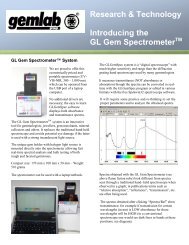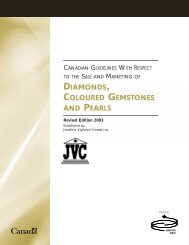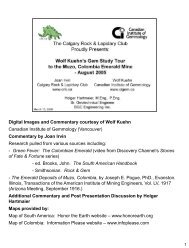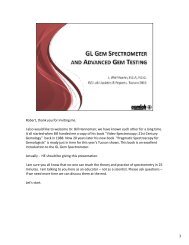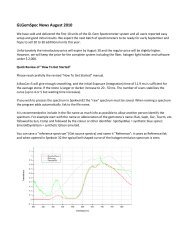JADEITE - Canadian Institute of Gemmology
JADEITE - Canadian Institute of Gemmology
JADEITE - Canadian Institute of Gemmology
Create successful ePaper yourself
Turn your PDF publications into a flip-book with our unique Google optimized e-Paper software.
associated with large and possibly active fault zones that are major crustal boundaries (e.g., the San<br />
Andreas Fault) and involve mostly horizontal motion" and "most jadeite rocks occur in relatively<br />
young geologic terrain, Cretaceous age or younger (less than 100 million years)." In sum, Harlow<br />
(1993: 14) argues that "these facts strongly suggest a genetic relationship between plate tectonics...<br />
and the formation and surface appearance <strong>of</strong> jadeite rock."<br />
Burma. Most <strong>of</strong> the jadeite produced in the world at present comes from northern Burma.<br />
This has been the sole source <strong>of</strong> fine "Imperial" jadeite for several centuries. Bender (1983)<br />
describes the geology <strong>of</strong> the jadeite mining region in Burma. It is characterized by an extensive<br />
broken outcropping containing bodies <strong>of</strong> serpentinized peridotite (their age ranging from Late<br />
Cretaceous to Eocene). The serpentinites found here are surrounded by crystalline schists and<br />
plutonic rocks (such as granites and monzonites). Jadeite was formed independently <strong>of</strong> the<br />
intrusives by crystallization from hydrous fluids (there were derived by dewatering <strong>of</strong> the subducted<br />
Indian plate) that rose along fractures in the serpentinized peridotite at relatively high-pressure and<br />
low-temperature during the Tertiary formation <strong>of</strong> the Himalayas. Fluids that form in these special<br />
conditions are saturated with sodium aluminosilicates. The passage <strong>of</strong> these fluids through<br />
serpentinites generated jadeitite, albite-nephaline, and albitite dikes (jadeite being generated at higher<br />
pressure and albite at lower pressure). The dikes commonly have central zones <strong>of</strong> jadeite and outer<br />
rims <strong>of</strong> chlorite and amphibolite at the point <strong>of</strong> contact with the serpentinites (see Harlow and Olds<br />
1987).<br />
This region commonly is referred to as the "Jade Tract" or "Jade Land." The latter term is<br />
roughly equivalent to the Burmese term for the region: Kyaukseinmyo.It is a rugged plateau located<br />
over 400 kilometers north <strong>of</strong> Mandalay. The main river in the area is the Uru, which serves roughly<br />
as the eastern boundary <strong>of</strong> the Jade Tract. The most important mining area in the region is located at<br />
Tawmaw (see Chhibber 1934: fig. 1, pg. 25), about 120 kilometers northwest <strong>of</strong> Mogaung. Mining<br />
has been going on in the Tawmaw area at least since the nineteenth century and Tawnaw is a source<br />
<strong>of</strong> most major varieties and colors <strong>of</strong> jadeite. Most <strong>of</strong> the jadeite from this area comes from<br />
secondary deposits in the Uru Boulder Conglomerate. The conglomerate is exposed over an area<br />
ranging in width from three to over six kilometers (the widest point being at Mamon) and up to 300<br />
meters thick (see Chhibber 1934). There are a number <strong>of</strong> secondary deposits located west <strong>of</strong> the<br />
Uru River, such as those at Sate Mu, Hpakangyi (adjacent to Hpakan), and Maw-sisa.<br />
The town <strong>of</strong> Mogaung served as the primary jadeite trading center throughout most <strong>of</strong> the<br />
modern history <strong>of</strong> jadeite mining in the Jade Tract. Mogaung is located a little over 100 kilometers<br />
west <strong>of</strong> Myitkyina town. It served as a collection and storage center for rough jadeite. Here the<br />
material was graded prior to shipping. The importance <strong>of</strong> Mogaung has declined and Hpakan (also<br />
spelled Hpakant, Phakan, or Phakant) has emerged as the primary center in recent years. Hpakan<br />
lies along the Uru River some sixteen kilometers by road from Tawmaw.<br />
23




